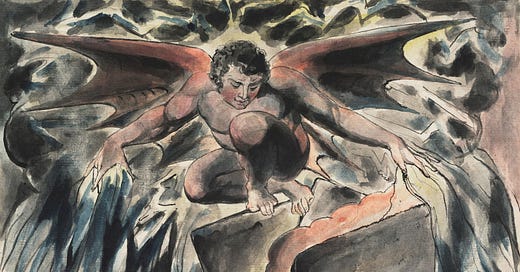“No other work in the Bible tries to take on the appearance of as many different themes and types as [the Book of Job] does. But what is particularly important to realize is that parody serves as the common denominator in all cases; that is, the author never intends merely to portray parallel upon parallel. Rather, in every instance where the author of Job incorporates something from his religious/literary/cultural milieu—whether it be an allusion to Canaanite religion or saga, the inspiration of legalistic terminology, a lament form, the format of a dialogue, a Righteous Sufferer’s Appeal, or whatever, the intent is never simply to imitate but also to oppose: to depict not only the convention but also the counterpoint to the convention. Thus, each archetype is set up only to be knocked down; and this overall parodistic intent gives what might otherwise seem a chaotic jumble or disparate motifs its shape and logic.”
~Bruce Zuckerman, Job the Silent
The word of God, or Satan’s primary instrument of deception? Is it possible the Bible is really both-in-one? Opposites attract, they say. But also that oil and water do not mix. So which is it?
Rene Girard’s theory of mimetic rivalry describes how, when two individuals get too close together, become too alike in qualities, they end up at war. This is because they are drawn to possess the same object. In the present case, the object is the human soul: both God and the Satan want it.
Yahweh and Lucifer, Cain and Abel, Jacob and Esau (Jasun and Dave?).
Recently, I read a 1991 book called Job the Silent: A Study in Historical Counterpoint, by Bruce Zuckerman. The thesis of the book, as quoted above, is that the main content of the Book of Job (the poetic passages) was written as an intentional parody of Hebrew scripture and belief, but that it did its job (pun intended) so well that it ended up being mistaken for the very thing it parodied.
What better way to neutralize the threat of parody than to canonize it? In the process (as I explored with The Kubrickon), the reader’s ability to discern nuance and subtlety—which all good parody depends on—must be hijacked, so we end up missing the whole point. This is a circular, mutually reinforcing strategy; for what better way to impair discernment (as Zuckerman argues) than by canonizing parody, by telling us that what we think we are seeing is not really what we are seeing, at all?
It is like a perverse variation on John Ford’s famous axiom. When truth becomes parody, print the parody.
As an example of his argument, Zuckerman cites a late 19th century Yiddish folk story called “Bontsye the Silent,” by Y. L. Perets. The story recounts the tale of a Jewish nebbish, Bontsye, who lives and dies without anyone ever noticing his existence, and yet whose arrival in (the Jewish equivalent of) Heaven is eagerly awaited. Bontsye is so humble that, during his long life of hardship and servitude, he never once complained, lamented, or opened his mouth to criticize either God or Man. His place in Heaven seems assured, then, and the heavenly trial on his arrival is a mere formality. Even the Prosecuting Angel (presumably the very same Satan who questions Job’s virtue) chooses to keep silent, as if deciding not to waste his breath.
Far from celebrating Bontsye’s piety, the Angels are worried that his silence, patience and humility, in the face of so much earthly sufferance, will leave the heavenly accounts bankrupt once Bontsye is fully compensated in the afterlife. It is with trepidation, therefore, that they offer him anything in all of God’s creation for his reward. When Bontsye finally opens his mouth to speak, after a stammered expression of surprise, all he asks for is ~ a hot roll with butter in the mornings!
In the final lines in the tale, the Angels lower their heads in shame, followed by a burst of laughter from the Prosecuting Angel.
Take a moment to think about how you respond to this tale. What is your impression of Bontsye, and of the meaning of the closing lines?
Zuckerman argues (convincingly) that these lines are the key to understanding the true nature and intent of Perets’ story. The Prosecuting Angel’s laughter, he says, following as it does the Angels’ embarrassment at Bontsye’s pitiful request, is meant to indicate that Bontsye’s silence is not the silence of a saint, but that of a simpleton. Perets thereby “flips” his story, from a celebration of Jewish piety, into a parody of it.
But here’s the clincher: Zuckerman describes how the story of Bontsye has been received and revered, over the ensuing centuries, not as a parody, at all, but as the genuine article. Translations into English, and the many accompanying commentaries and analyses, have all gone out of their way to push this reading, have even gone so far as to erase the final revelation, e.g., by adding the word “bitter” to the Prosecuting Angel’s laughter, or simply removing it entirely. The shame of the Angels then becomes, not the result of realizing they have mistaken an idiot for a sage (like Chancey Gardener in Being There), but the final confirmation of Bontsye’s holiness: of a purity so pure it makes the Angels look bad.
People believe what they want to believe. Or what they need to believe. Or what they are told to believe, because others need them to believe it.
Since Perets was known for sincere parables of Jewish piety, and not for cheeky parodies, that was what this story had to be. And so it would be made to be, by official decree, and the author’s intentions be damned.





